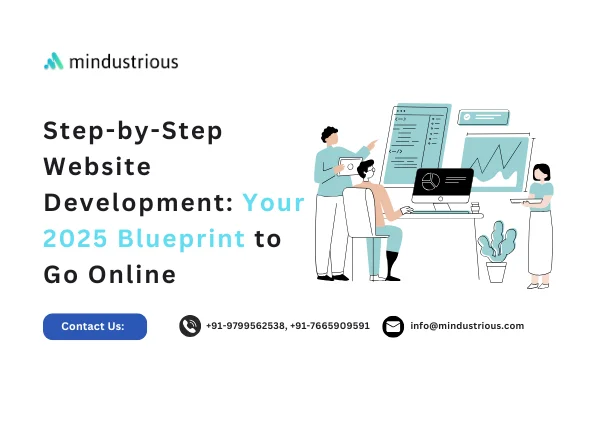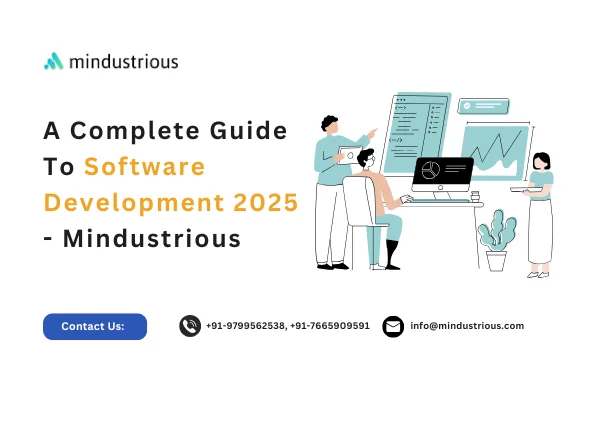I am Sushil who brings more than 8 years of application development background through which I gained experience across mobile applications and enterprise solution development.
I will give you a complete tutorial about 2025 app development which presents all essential information starting from fundamental procedures through successful implementations in my work.
All businesses that want to develop their initial app or developers who want to succeed in application building will find valuable insights through this guide. If you want software development services for your brand, it is best to know the right thing!
What is Application Development?
The process of developing programs and their sets for practical user benefits makes up application development. Programs built during app development work across different operating systems that include mobile devices as well as desktops and browsers.
The app development sequence begins with planning and advancement moves through designing and programming until it reaches testing and deployment.
The success of businesses greatly depends on custom applications which match their operational requirements according to my experience in app development. A quality app raises operational efficiency and ensures greater customer connection while making businesses more successful in their market competition.
Why Is Mobile App Development Important?
The primary goal for which businesses initially pursued app development was customer interaction. Mobile applications establish unobstructed communication that enables customers to reach services and make transactions while receiving updates easily.
Your organization will receive business advantages that exceed basic customer interface tools. Developing an app serves several vital purposes that benefit your business operations.
- Improved Customer Engagement: Business applications let organizations maintain better interaction with their customers through both push alerts and simpler dialogue capabilities and toolkits for updates.
- Enhanced Branding: Your brand can leverage a professionally designed app as its organizational extension. Through this platform businesses use it to present their products or services while creating better bonds with their target audience.
- Streamlined Operations: Business applications developed specifically for companies enable automation of operations which both shortens work hours and prevents human mistakes from occurring.
- Data-Driven Decisions: Using app usage data enables you to deduce customer patterns that generate improvements for your services.
Application Development Lifecycle: Phases and Steps Explained
The development process I use for apps consists of structured stages which enable all operations to occur efficiently. The creation of my applications consists of these principal phases which I use for development:
1. Planning and Research
A successful application initiates from an organized foundation. My process starts with discussing the application purpose in depth with each client. What problem is it solving? What features do users need? During this phase I concentrate on both researching the target audience while performing market research as well as analyzing competitors.
Here’s a simple example of what I consider during planning:
- Target Audience: Who will use the app? What do they need?
- Technical Requirements: Do I need to integrate the app with existing systems or databases?
- Budget & Timeline: How much time and resources do I have to complete the project?
2. Design and Prototyping
After establishing a complete grasp of the app’s goals I advance to the design phase. Prior to beginning my work I produce paper sketches which prioritize UX and UI design for the application framework. I follow the wireframe development with the creation of prototypes to showcase the app functionality.
Through mobile app development I maintain simple design logic for applications which features easy navigation and interface consistency. A mobile app screen typically contains this following design structure:
|
+------------------------------+ | Header | | (App name) | +------------------------------+ | Home | Settings | Profile | +------------------------------+ | Main content area | | (Buttons, Forms, etc.) | +------------------------------+ |
The main priority in designing this application aims to provide users with an easy and fluid way to move between screens.
3. Code Development
Moving forward to the implementation stage after writers obtain the design concept. The development of applications contains two main sections as front-end development and back-end development.
Front-End Development describes every component that consumers encounter while using the software. The interface presentation along with design characteristics along with operational functions comprise front-end development.
At this point I execute the front-end work targeting smooth transition practices alongside clear interface navigation alongside user-responsive design elements.
The construction of a basic web application login form utilizes HTML and CSS through this following example:
|
<form> <label for="username">Username:</label> <input type="text" id="username" name="username"> <label for="password">Password:</label> <input type="password" id="password" name="password"> <button type="submit">Login</button> </form> |
Back-End Development: This is the part of the app that runs behind the scenes. It’s responsible for processing data, handling user requests, and interacting with databases.
Here’s an example of a simple Node.js back-end function to handle user login:
|
const express = require('express'); const app = express(); app.post('/login', (req, res) => { const { username, password } = req.body; // Check credentials against database if (username === 'admin' && password === 'password123') { res.send('Login successful'); } else { res.send('Invalid credentials'); } }); app.listen(3000, () => console.log('Server running on port 3000')); |
In this phase, the goal is to ensure that both the front-end and back-end work harmoniously together, providing users with the experience they expect.
4. Testing and Optimization
Once the app is built, it’s time for rigorous testing. I ensure that everything works as expected by performing tests such as:
- Unit Testing: Testing individual components of the app to make sure they function properly.
- User Testing: Getting feedback from real users to identify usability issues.
- Performance Testing: Ensuring the app runs smoothly, even under high traffic.
After testing, I focus on optimization. This can include speeding up load times, optimizing code for better performance, and ensuring that the app works across different devices and platforms.
5. Release and Maintenance
After final testing, I launch the app. But my work doesn’t end there. I continue to monitor the app post-launch to ensure it’s running smoothly. During this phase, I also address any bugs or issues that arise and may release updates with new features or improvements.
How App Development Differs from Software Development
While both app development and software development involve coding and programming, there are key differences. As an app developer, I often focus more on the user experience and interface, ensuring the app is easy to use and visually appealing. Software development, on the other hand, often involves building complex systems with broader functionalities.
In my experience:
- App Development: Focuses on design, functionality, and user experience.
- Software Development: Often involves deeper technical specifications and extensive documentation.
Types of Application Development
Over the years, I’ve worked with different types of app development. Below are some of the most common approaches I use:
- Rapid Application Development (RAD): This is all about speed and agility. In RAD, I use pre-built components and focus on getting feedback early and often. The goal is to build and release apps quickly.
- Custom Application Development: Sometimes businesses require a tailor-made solution, and that’s where custom apps come into play. This type of development ensures that the app is built specifically to meet the unique needs of the business.
- Enterprise Application Development: For large organizations, enterprise apps help automate and manage critical processes. These apps are more complex and often require collaboration between different teams within the company.
- Web Application Development: Unlike mobile apps, web apps are accessed through a browser. They tend to be simpler but are perfect for businesses looking for a cost-effective solution.
- Citizen Development: With the rise of low-code/no-code platforms, non-developers can now build apps too. While I usually build apps through traditional coding, it’s great to see how these platforms are empowering more people to create their own solutions.
The Future of App Development
Looking ahead, I’m excited to see how app development is evolving. With advancements in low-code/no-code platforms, non-technical users will be able to create powerful apps, reducing the reliance on professional developers. This opens up opportunities for more collaboration and faster app delivery.
Additionally, security will remain a top priority. As apps collect more user data, ensuring their protection will be crucial. Developers, including myself, will need to stay ahead of emerging threats and build secure applications from the ground up.
Wrapping Up
App development is a challenging but rewarding process. With my experience, I’ve learned that successful apps require clear planning, strong communication, and constant iteration. Whether you’re developing an app for your business or looking to enter the development world, remember that each step is important, and learning from every project will help you grow.
If you’re interested in creating an app, I recommend starting with a simple project and gradually scaling up as you gain experience. With the right tools, the right team, and a solid strategy, you can build an app that delivers real value to your users.
Let me know if you have any questions, and happy coding!



